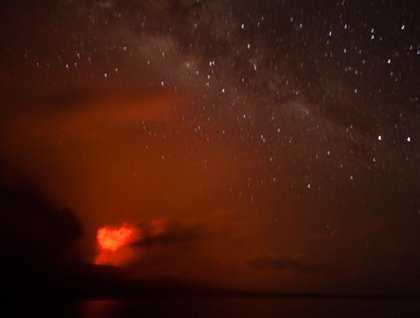The story begins at midnight last night while we were still admiring the eruption of Wolf Volcano juxtaposed against billions of stars in the Milky Way shining brightly overhead. The vastness of the cosmos are clearly seen when we’re exploring these remote areas. Perhaps millions of galaxies shine overhead, alongside billions of stars in our own galaxy. Seeing that with an erupting volcano in the foreground might just be enough to change your life.
After a well-deserved rest, we woke at dawn to explore the shoreline of Santiago Island. The weather was challenging at first, dousing us in a warm gentle rain. Soon the rain moved on, and as the clouds broke behind us, it formed a rainbow over the National Geographic Endeavour. Okay, so it wasn’t right over the ship, but you can always move the rainbow by walking farther down the beach. Overhead, blue-footed boobies and pelicans flew through the vibrant colors while diving for their breakfast.
After breakfast, we disembarked the ship for a variety of activities including kayaking, cruising in the glass-bottomed boat, and most popular – snorkeling. We saw large parrotfish, schools of yellow-tailed surgeonfish, and a myriad of other fishes.
Today we are following in the footsteps of Charles Darwin, as this is the island where he spent most of his time in Galápagos. We are anchoring where the HMS Beagle anchored, and exploring the same beautiful shoreline. In the afternoon we divided into two groups to snorkel and explore collapsed lava tubes underwater, or continue photographing the coastline. Along our photo walk, we found countless Galápagos sea lions, as well as the more rare Galápagos fur seal, which technically is also a sea lion despite its incorrect nomenclature.
The beauty of Santiago Island extends past its visual offerings, as it also means a great deal to us as a story of success. Lindblad Expeditions adopted the island several years ago to save it from environmental collapse, and thanks to our amazing guests, we were able to raise enough money to rid the island of more than 86,000 goats, which were decimating the island’s flora and fauna. The project took several years and incorporated the help of several nongovernmental organizations, the Galapagos National Park, expert aerial marksmen, and countless others. It was funded primarily by the guests aboard the National Geographic expedition ships, and is one of the best examples I know of how ecotourism benefits these remarkable places. It is part of why I am honored to work for this company.









